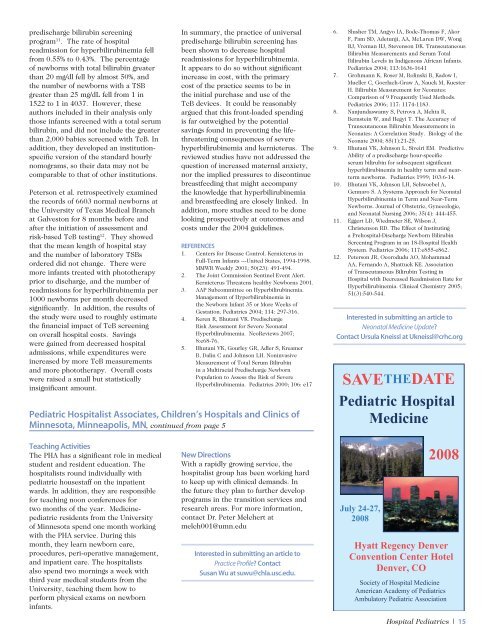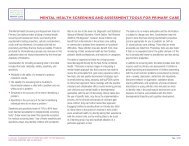Susan Wu, MD, FAAP, Editor - American Academy of Pediatrics
Susan Wu, MD, FAAP, Editor - American Academy of Pediatrics
Susan Wu, MD, FAAP, Editor - American Academy of Pediatrics
You also want an ePaper? Increase the reach of your titles
YUMPU automatically turns print PDFs into web optimized ePapers that Google loves.
predischarge bilirubin screening<br />
program 11 . The rate <strong>of</strong> hospital<br />
readmission for hyperbilirubinemia fell<br />
from 0.55% to 0.43%. The percentage<br />
<strong>of</strong> newborns with total bilirubin greater<br />
than 20 mg/dl fell by almost 50%, and<br />
the number <strong>of</strong> newborns with a TSB<br />
greater than 25 mg/dL fell from 1 in<br />
1522 to 1 in 4037. However, these<br />
authors included in their analysis only<br />
those infants screened with a total serum<br />
bilirubin, and did not include the greater<br />
than 2,000 babies screened with TcB. In<br />
addition, they developed an institutionspecific<br />
version <strong>of</strong> the standard hourly<br />
nomograms, so their data may not be<br />
comparable to that <strong>of</strong> other institutions.<br />
Peterson et al. retrospectively examined<br />
the records <strong>of</strong> 6603 normal newborns at<br />
the University <strong>of</strong> Texas Medical Branch<br />
at Galveston for 8 months before and<br />
after the initiation <strong>of</strong> assessment and<br />
risk-based TcB testing 12 . They showed<br />
that the mean length <strong>of</strong> hospital stay<br />
and the number <strong>of</strong> laboratory TSBs<br />
ordered did not change. There were<br />
more infants treated with phototherapy<br />
prior to discharge, and the number <strong>of</strong><br />
readmissions for hyperbilirubinemia per<br />
1000 newborns per month decreased<br />
significantly. In addition, the results <strong>of</strong><br />
the study were used to roughly estimate<br />
the financial impact <strong>of</strong> TcB screening<br />
on overall hospital costs. Savings<br />
were gained from decreased hospital<br />
admissions, while expenditures were<br />
increased by more TcB measurements<br />
and more phototherapy. Overall costs<br />
were raised a small but statistically<br />
insignificant amount.<br />
In summary, the practice <strong>of</strong> universal<br />
predischarge bilirubin screening has<br />
been shown to decrease hospital<br />
readmissions for hyperbilirubinemia.<br />
It appears to do so without significant<br />
increase in cost, with the primary<br />
cost <strong>of</strong> the practice seems to be in<br />
the initial purchase and use <strong>of</strong> the<br />
TcB devices. It could be reasonably<br />
argued that this front-loaded spending<br />
is far outweighed by the potential<br />
savings found in preventing the lifethreatening<br />
consequences <strong>of</strong> severe<br />
hyperbilirubinemia and kernicterus. The<br />
reviewed studies have not addressed the<br />
question <strong>of</strong> increased maternal anxiety,<br />
nor the implied pressures to discontinue<br />
breastfeeding that might accompany<br />
the knowledge that hyperbilirubinemia<br />
and breastfeeding are closely linked. In<br />
addition, more studies need to be done<br />
looking prospectively at outcomes and<br />
costs under the 2004 guidelines.<br />
REFERENCES<br />
1. Centers for Disease Control. Kernicterus in<br />
Full-Term Infants ---United States, 1994-1998.<br />
MMWR Weekly 2001; 50(23): 491-494.<br />
2. The Joint Commission Sentinel Event Alert.<br />
Kernicterus Threatens healthy Newborns 2001.<br />
3. AAP Subcommittee on Hyperbilirubinemia.<br />
Management <strong>of</strong> Hyperbilirubinemia in<br />
the Newborn Infant 35 or More Weeks <strong>of</strong><br />
Gestation. <strong>Pediatrics</strong> 2004; 114: 297-316.<br />
4. Keren R, Bhutani VK. Predischarge<br />
Risk Assessment for Severe Neonatal<br />
Hyperbilirubinemia. NeoReviews 2007;<br />
8:e68-76.<br />
5. Bhutani VK, Gourley GR, Adler S, Kreamer<br />
B, Dalin C and Johnson LH. Noninvasive<br />
Measurement <strong>of</strong> Total Serum Bilirubin<br />
in a Multiracial Predischarge Newborn<br />
Population to Assess the Risk <strong>of</strong> Severe<br />
Hyperbilirubinemia. <strong>Pediatrics</strong> 2000; 106: e17<br />
Pediatric Hospitalist Associates, Children’s Hospitals and Clinics <strong>of</strong><br />
Minnesota, Minneapolis, MN, continued from page 5<br />
Teaching Activities<br />
The PHA has a significant role in medical<br />
student and resident education. The<br />
hospitalists round individually with<br />
pediatric housestaff on the inpatient<br />
wards. In addition, they are responsible<br />
for teaching noon conferences for<br />
two months <strong>of</strong> the year. Medicinepediatric<br />
residents from the University<br />
<strong>of</strong> Minnesota spend one month working<br />
with the PHA service. During this<br />
month, they learn newborn care,<br />
procedures, peri-operative management,<br />
and inpatient care. The hospitalists<br />
also spend two mornings a week with<br />
third year medical students from the<br />
University, teaching them how to<br />
perform physical exams on newborn<br />
infants.<br />
New Directions<br />
With a rapidly growing service, the<br />
hospitalist group has been working hard<br />
to keep up with clinical demands. In<br />
the future they plan to further develop<br />
programs in the transition services and<br />
research areas. For more information,<br />
contact Dr. Peter Melchert at<br />
melch001@umn.edu<br />
Interested in submitting an article to<br />
Practice Pr<strong>of</strong>ile? Contact<br />
<strong>Susan</strong> <strong>Wu</strong> at suwu@chla.usc.edu.<br />
6. Slusher TM, Angyo IA, Bode-Thomas F, Akor<br />
F, Pam SD, Adetunji, AA, McLaren DW, Wong<br />
RJ, Vreman HJ, Stevenson DK. Transcutaneous<br />
Bilirubin Measurements and Serum Total<br />
Bilirubin Levels in Indigenous African Infants.<br />
<strong>Pediatrics</strong> 2004; 113:1636-1641<br />
7. Grohmann K, Roser M, Rolinski B, Kadow I,<br />
Mueller C, Goerlach-Graw A, Nauck M, Kuester<br />
H. Bilirubin Measurement for Neonates:<br />
Comparison <strong>of</strong> 9 Frequently Used Methods.<br />
<strong>Pediatrics</strong> 2006; 117: 1174-1183.<br />
8. Nanjundaswamy S, Petrova A, Mehta R,<br />
Bernstein W, and Hegyi T. The Accuracy <strong>of</strong><br />
Transcutaneous Bilirubin Measurements in<br />
Neonates: A Correlation Study. Biology <strong>of</strong> the<br />
Neonate 2004; 85(1):21-25.<br />
9. Bhutani VK, Johnson L, Siveiri EM. Predictive<br />
Ability <strong>of</strong> a predischarge hour-specific<br />
serum bilirubin for subsequent significant<br />
hyperbilirubinemia in healthy term and nearterm<br />
newborns. <strong>Pediatrics</strong> 1999; 103:6-14.<br />
10. Bhutani VK, Johnson LH, Schwoebel A,<br />
Gennaro S. A Systems Approach for Neonatal<br />
Hyperbilirubinemia in Term and Near-Term<br />
Newborns. Journal <strong>of</strong> Obstetric, Gynecologic,<br />
and Neonatal Nursing 2006; 35(4): 444-455.<br />
11. Eggert LD, Wiedmeier SE, Wilson J,<br />
Christenson RD. The Effect <strong>of</strong> Instituting<br />
a Prehospital-Discharge Newborn Bilirubin<br />
Screening Program in an 18-Hospital Health<br />
System. <strong>Pediatrics</strong> 2006; 117:e855-e862.<br />
12. Peterson JR, Ocorodudu AO, Mohammad<br />
AA, Fernando A, Shattuck KE. Association<br />
<strong>of</strong> Transcutaneous Bilirubin Testing in<br />
Hospital with Decreased Readmission Rate for<br />
Hyperbilirubinemia. Clinical Chemistry 2005;<br />
51(3):540-544.<br />
Interested in submitting an article to<br />
Neonatal Medicine Update?<br />
Contact Ursula Kneissl at Ukneissl@crhc.org<br />
Hospital <strong>Pediatrics</strong> | 15



